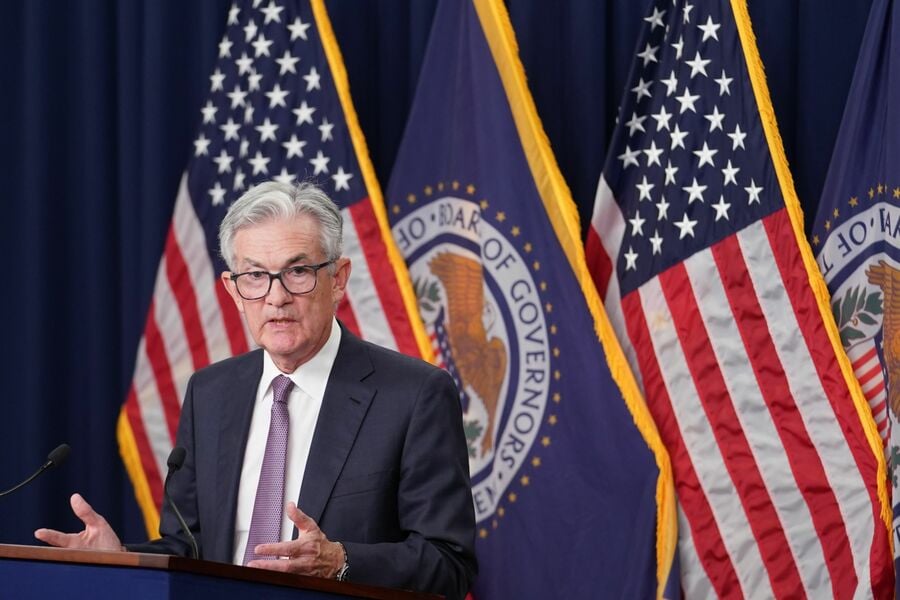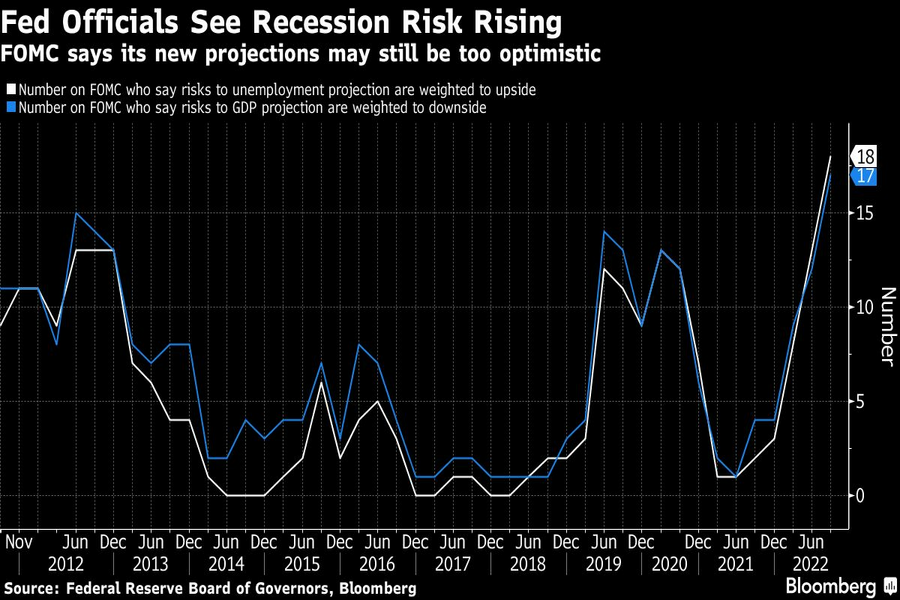

Federal Reserve officials gave their clearest signal yet that they’re willing to tolerate a recession as the necessary trade-off for regaining control of inflation.
Policy makers, criticized for being too late to realize the scale of the U.S. inflation problem, are moving aggressively to catch up. They raised interest rates by 75 basis points on Wednesday for the third time in a row and forecast a further 1.25 percentage points of tightening before year end.
That was more hawkish than expected by economists. In addition, officials cut growth projections, raised their unemployment outlook and Chair Jerome Powell repeatedly spoke of the painful slowdown that’s needed to curb price pressures running at the highest levels since the 1980s.
“Powell’s admission that there will be below-trend growth for a period should be translated as central bank speak for ‘recession,’” said Seema Shah of Principal Global Investors. “Times are going to get tougher from here.”

To be clear, Fed officials aren’t explicitly projecting a recession. But Powell’s rhetoric about the rate hikes likely causing pain for workers and businesses has gotten progressively sharper in recent months. On Wednesday, in his post-meeting press conference, Powell said a soft landing with only a small increase in joblessness would be “very challenging.”
“No one knows whether this process will lead to a recession or if so, how significant that recession would be,” Powell told reporters after officials lifted the target range for their benchmark rate to 3% to 3.25%. “The chances of a soft landing are likely to diminish to the extent that policy needs to be more restrictive, or restrictive for longer. Nonetheless, we’re committed to getting inflation back down to 2%.”
That sober assessment is in sharp contrast from six months ago, when Fed officials first started raising rates from near zero and pointed to the economy’s strength as a positive — something that would shield people from feeling the effects of a cooling economy.
Officials now implicitly acknowledge, via their more pessimistic unemployment projections, that demand will need to be curtailed at every level of the economy, as inflation has proved to be persistent and widespread.
The median forecast among the 19 Fed officials is for unemployment to reach 4.4% next year and stay there through 2024, from the current rate of 3.7%. But even that new level might still be too low. Almost all participants said risks to their new forecasts were weighted to the upside. They projected interest rates reaching 4.4% this year and 4.6% in 2023, before moderating to 3.9% in 2024.

“We have always understood that restoring price stability while achieving a relatively modest increase in unemployment and a soft landing would be very challenging,” Powell said Wednesday. “We have got to get inflation behind us. I wish there were a painless way to do that. There isn’t.”
Fed officials’ apprehension about their ability to bring down inflation is evident in other projections, too. Even amid a new rate-hike path, officials still don’t see inflation easing to their 2% target until 2025.
If they privately suspect that this means the risk of recession is rising, they aren’t saying so out loud.
“I think they understand it is increasing, although it is still not their goal,” said Laura Rosner-Warburton, senior U.S. economist at the research firm MacroPolicy Perspectives in New York. “Soft landing or not is sort of out of their control and dependent on factors like supply improvement, which they can’t rely on or wait for.”
Powell told reporters several times that a softer labor market may be necessary to sufficiently bring down demand. But he also pointed to higher savings rates and more money at the state level indicating that the economy is still reasonably strong, a “good thing” that he said would make it more resistant to a significant downturn.
That was met with skepticism.
“There has never been a half-percent increase in unemployment without a recession,” said Roberto Perli, head of global policy research at Piper Sandler & Co. “Therefore, it is very likely. They know this. History says it normally does not happen.”
Perli sees another 75 basis-point hike in November, followed by a half-point increase in December. A number of economists raised their forecasts on Wednesday for where Fed rates would peak.
Bank of America Corp. now sees hikes of 75 basis points in November, 50 basis points in December and two quarter-point increases in early 2023, bringing the Fed’s benchmark rate to a target range of 4.75% to 5%. Economists at Societe Generale are calling for a “mild recession” in early 2024. Goldman Sachs Group Inc. economists raised their forecast for the pace of Fed hikes.
Stephen Stanley, chief economist at Amherst Pierpont Securities, increased his terminal-rate outlook to 5.25%, saying he doesn’t think the Fed’s inflation forecasts are realistic and it’ll take increased tightening to bring price growth down.
“I see the first half of next year as a treacherous time for the Fed,” Stanley wrote in a note.
Whether the Fed ultimately stops at its current 4.6% forecast or goes higher, its tighter policy will bring job cuts, according to Bloomberg chief U.S. economist Anna Wong. Raising rates to 4.5% would cost about 1.7 million jobs, and rates at 5% would mean 2 million fewer jobs, she said.
Powell acknowledged that rates may have to higher than currently expected.
“We’ve written down what we think is a plausible path for the federal funds rate,” he said. “The path that we actually execute will be enough. It will be enough to restore price stability.”

A new proposal could end the ban on promoting client reviews in states like California and Connecticut, giving state-registered advisors a level playing field with their SEC-registered peers.

Morningstar research data show improved retirement trajectories for self-directors and allocators placed in managed accounts.

Some in the industry say that more UBS financial advisors this year will be heading for the exits.

The Wall Street giant has blasted data middlemen as digital freeloaders, but tech firms and consumer advocates are pushing back.

Research reveals a 4% year-on-year increase in expenses that one in five Americans, including one-quarter of Gen Xers, say they have not planned for.
Orion's Tom Wilson on delivering coordinated, high-touch service in a world where returns alone no longer set you apart.
Barely a decade old, registered index-linked annuities have quickly surged in popularity, thanks to their unique blend of protection and growth potential—an appealing option for investors looking to chart a steadier course through today's choppy market waters, says Myles Lambert, Brighthouse Financial.
